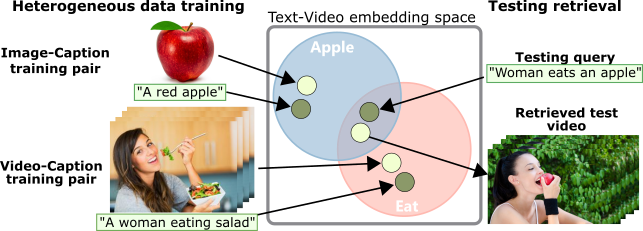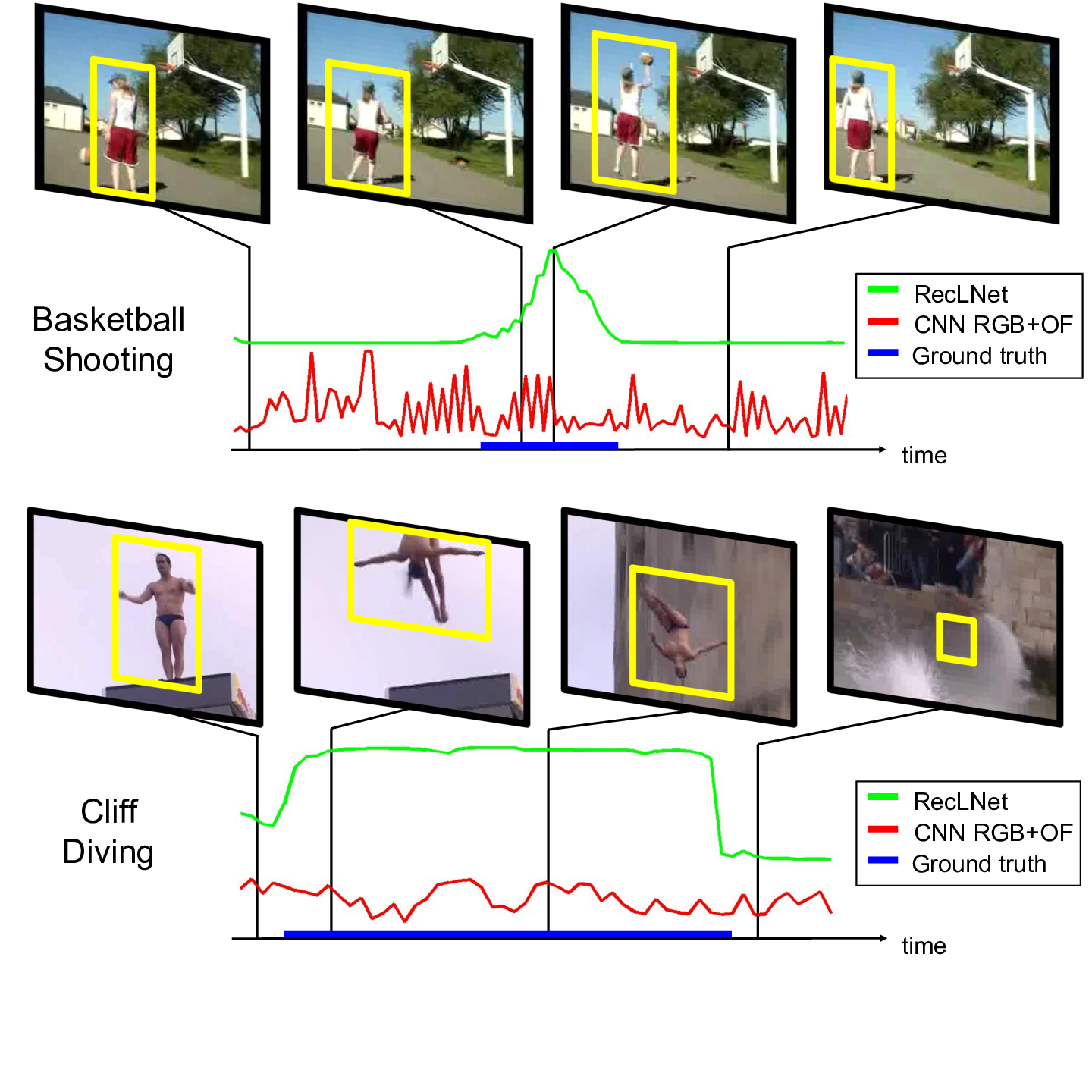Section: New Results
Human activity capture and classification
Learning a Text-Video Embedding from Incomplete and Heterogeneous Data
Participants : Antoine Miech, Ivan Laptev, Josef Sivic.
Joint understanding of video and language is an active research area with many applications. Prior work in this domain typically relies on learning text-video embeddings. One difficulty with this approach, however, is the lack of large-scale annotated video-caption datasets for training. To address this issue, in [29] we aim at learning text-video embeddings from heterogeneous data sources. To this end, we propose a Mixture-of-Embedding-Experts (MEE) model with ability to handle missing input modalities during training. As a result, our framework can learn improved text-video embeddings simultaneously from image and video datasets. We also show the generalization of MEE to other input modalities such as face descriptors. We evaluate our method on the task of video retrieval and report results for the MPII Movie Description and MSR-VTT datasets. The proposed MEE model demonstrates significant improvements and outperforms previously reported methods on both text-to-video and video-to-text retrieval tasks. Figure 11 illustrates application of our method in text-to-video retrieval.
|
A flexible model for training action localization with varying levels of supervision
Participants : Guilhem Chéron, Jean-Baptiste Alayrac, Ivan Laptev, Cordelia Schmid.
Spatio-temporal action detection in videos is typically addressed in a fully-supervised setup with manual annotation of training videos required at every frame. Since such annotation is extremely tedious and prohibits scalability, there is a clear need to minimize the amount of manual supervision. In this work we propose a unifying framework that can handle and combine varying types of less-demanding weak supervision. Our model is based on discriminative clustering and integrates different types of supervision as constraints on the optimization as illustrated in Figure 12. We investigate applications of such a model to training setups with alternative supervisory signals ranging from video-level class labels to the full per-frame annotation of action bounding boxes. Experiments on the challenging UCF101-24 and DALY datasets demonstrate competitive performance of our method at a fraction of supervision used by previous methods. The flexibility of our model enables joint learning from data with different levels of annotation. Experimental results demonstrate a significant gain by adding a few fully supervised examples to otherwise weakly labeled videos. This work has been published in [14].
|
BodyNet: Volumetric Inference of 3D Human Body Shapes
Participants : Gül Varol, Duygu Ceylan, Bryan Russell, Jimei Yang, Ersin Yumer, Ivan Laptev, Cordelia Schmid.
Human shape estimation is an important task for video editing, animation and fashion industry. Predicting 3D human body shape from natural images, however, is highly challenging due to factors such as variation in human bodies, clothing and viewpoint. Prior methods addressing this problem typically attempt to fit parametric body models with certain priors on pose and shape. In this work we argue for an alternative representation and propose BodyNet, a neural network for direct inference of volumetric body shape from a single image. BodyNet is an end-to-end trainable network that benefits from (i) a volumetric 3D loss, (ii) a multi-view re-projection loss, and (iii) intermediate supervision of 2D pose, 2D body part segmentation, and 3D pose. Each of them results in performance improvement as demonstrated by our experiments. To evaluate the method, we fit the SMPL model to our network output and show state-of-the-art results on the SURREAL and Unite the People datasets, outperforming recent approaches. Besides achieving state-of-the-art performance, our method also enables volumetric body-part segmentation. Figure 13 illustrates the volumetric outputs given two sample input images. This work has been published at ECCV 2018 [22].
|
Localizing Moments in Video with Temporal Language
Participants : Lisa Anne Hendricks, Oliver Wang, Eli Schechtman, Josef Sivic, Trevor Darrell, Bryan Russell.
Localizing moments in a longer video via natural language queries is a new, challenging task at the intersection of language and video understanding. Though moment localization with natural language is similar to other language and vision tasks like natural language object retrieval in images, moment localization offers an interesting opportunity to model temporal dependencies and reasoning in text. In [15], we propose a new model that explicitly reasons about different temporal segments in a video, and shows that temporal context is important for localizing phrases which include temporal language. To benchmark whether our model, and other recent video localization models, can effectively reason about temporal language, we collect the novel TEMPO-ral reasoning in video and language (TEMPO) dataset. Our dataset consists of two parts: a dataset with real videos and template sentences (TEMPO - Template Language) which allows for controlled studies on temporal language, and a human language dataset which consists of temporal sentences annotated by humans (TEMPO - Human Language).
The Pinocchio C++ library ? A fast and flexible implementation of rigid body dynamics algorithms and their analytical derivatives
Participants : Justin Carpentier, Guilhem Saurel, Gabriele Buondonno, Joseph Mirabel, Florent Lamiraux, Olivier Stasse, Nicolas Mansard.
In this work, we introduce Pinocchio, an open-source software framework that implements rigid body dynamics algorithms and their analytical derivatives. Pinocchio does not only include standard algorithms employed in robotics (e.g., forward and inverse dynamics) but provides additional features essential for the control, the planning and the simulation of robots. In this paper, we describe these features and detail the programming patterns and design which make Pinocchio efficient. We evaluate the performances against RBDL, another framework with broad dissemination inside the robotics community. We also demonstrate how the source code generation embedded in Pinocchio outperforms other approaches of state of the art.
Modeling Spatio-Temporal Human Track Structure for Action Localization
Participants : Guilhem Chéron, Anton Osokin, Ivan Laptev, Cordelia Schmid.
This paper [24] addresses spatio-temporal localization of human actions in video. In order to localize actions in time, we propose a recurrent localization network (RecLNet) designed to model the temporal structure of actions on the level of person tracks. Our model is trained to simultaneously recognize and localize action classes in time and is based on two layer gated recurrent units (GRU) applied separately to two streams, i.e. appearance and optical flow streams. When used together with state-of-the-art person detection and tracking, our model is shown to improve substantially spatio-temporal action localization in videos. The gain is shown to be mainly due to improved temporal localization as illustrated in Figure 14. We evaluate our method on two recent datasets for spatio-temporal action localization, UCF101-24 and DALY, demonstrating a significant improvement of the state of the art.





